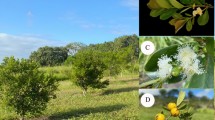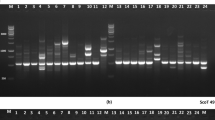Abstract.
The genetic diversity of apricot (Prunus armeniaca; 2n = 16) was studied using AFLP markers. Forty seven apricot cultivars were selected from the following geographic regions: Europe, North America, North Africa, Turkey, Iran and China. Five EcoRI-MseI AFLP primer combinations revealed 416 legible bands, of which 379 were polymorphic markers. A similarity matrix was prepared using the simple matching coefficient of similarity. A UPGMA dendrogram demonstrated a gradient of decreasing genetic diversity of varieties from the former USSR to Southern Europe. This is coherent with the historical dissemination of apricot from its center of origin in Asia. The American cultivars were intermediate demonstrating a different genetic base than the European and/or Mediterranean cultivars. Euclidean distances from the first ten Factorial Component Analysis coordinate axes were used to generate a tree using the Ward algorithm. The results of these analyses were evaluated based on the known geographic origins and agronomic characteristics of the cultivars studied. Four cultivar groups were identified: Diversification, Geographically Adaptable, Continental Europe and Mediterranean Basin. To evaluate the relationship of the common apricot with some closely related species, one or two accessions of the following related species or sub-species from within the section Armeniaca were included in the analysis: Prunus armeniaca var. ansu, Prunus mume, Prunus brigantiaca, Prunus dasycarpa, and Prunus holosericea. A Neighbour Joining dendrogram was made using the similarity matrix. The P. holosericea accession fell well within the cultivar group, thus supporting its classification as a variant of P. armeniaca. The P. armeniaca var. ansu accession was sister to the common apricot cluster with a bootstrap value of 96%. P. mume was farther removed. P. brigantiaca was the most-distant from the common apricots. P. dasycarpa was intermediate between P. brigantiaca and P. mume, in accord with its plum-apricot hybrid origin. The results have a direct application for the selection of new breeding progenitors.
Similar content being viewed by others
Author information
Authors and Affiliations
Additional information
Electronic Publication
Rights and permissions
About this article
Cite this article
Hagen, .L., Khadari, .B., Lambert, .P. et al. Genetic diversity in apricot revealed by AFLP markers: species and cultivar comparisons. Theor Appl Genet 105, 298–305 (2002). https://doi.org/10.1007/s00122-002-0910-8
Received:
Accepted:
Issue Date:
DOI: https://doi.org/10.1007/s00122-002-0910-8




